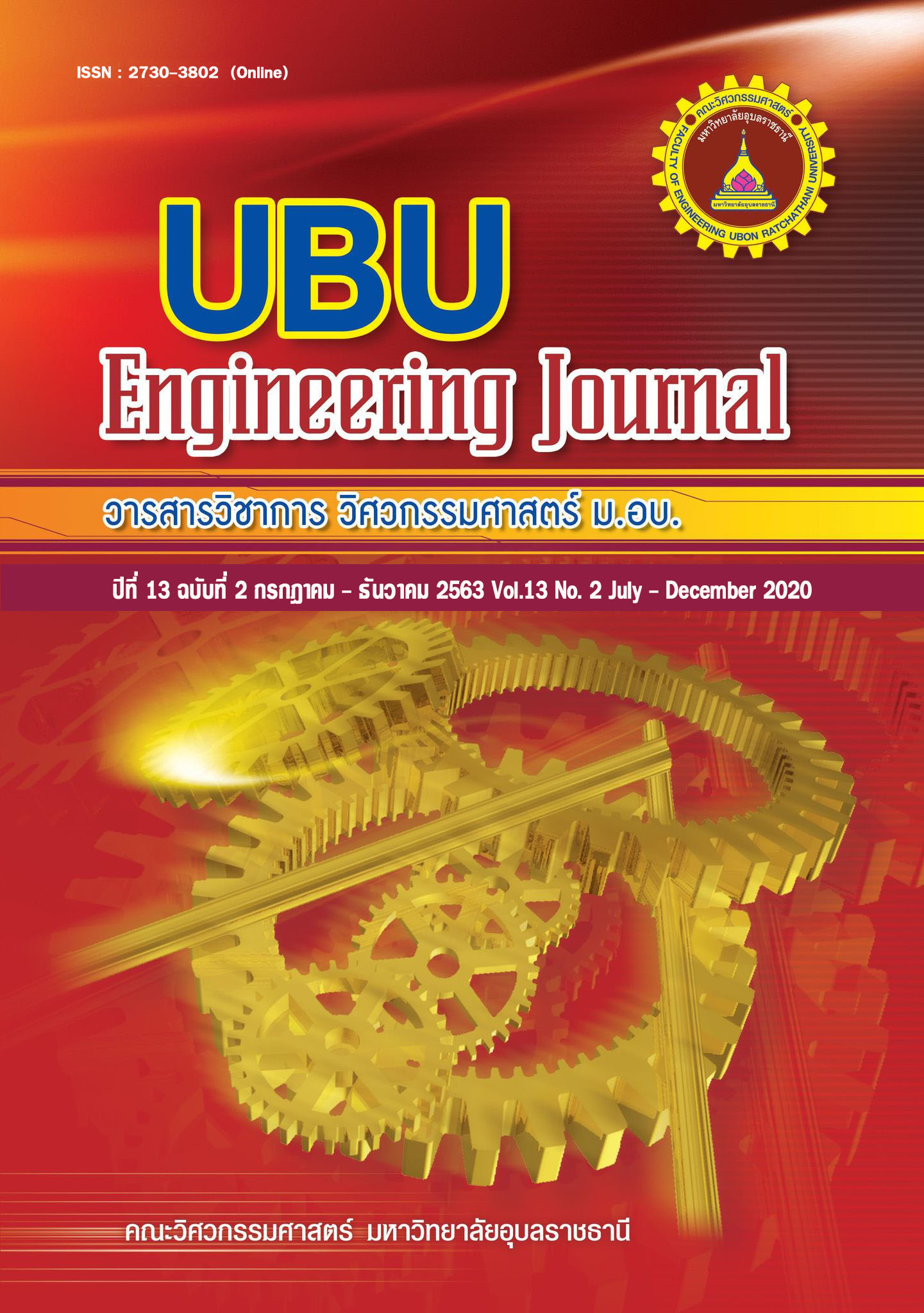Compressive Strength of Cellular Lightweight Concrete
Main Article Content
Abstract
This paper presents a study of compressive strength of cellular lightweight concrete adding superplasticizer for standard cylinder and cube specimens at dry unit weights 1600 - 1800 kg/m3 using water to cement ratios of 0.30, 0.35, 0.45 and 0.55, sand to cement ratios of 2:1 and 3:1 and adding superplasticizer dose of 0.0, 0.5 and 1.0 percent of cement weight in air-curing condition at the ages of 7, 14, 28 and 56 days, 24 designed mixes in total. From the study, it was found as the following. (1) The compressive strength of standard cube samples at the dry unit weight of 1600 kg/m3 found in between 58-185 ksc and the maximum compressive strength shown at the mix with sand to cement ratio of 2:1, water to cement ratio of 0.35 and using superplasticizer dose of 0.5 percent of cement weight. (2) At the designed unit weight of 1800 kg/m3, the compressive strength found in between 88-223 ksc and the maximum compressive strength shown at the mix with sand to cement ratio of 2:1, water to cement ratio of 0.30 and using superplasticizer dose of 1.0 percent of cement weight. (3) The development of compressive strength of both cylinder and cube samples seems to be faster than the conventional concrete. The compressive strength at the age of 7 and 14 days are approximately 90 percent of the strength at 28 days and at the age of 56 days the compressive strength is higher than the strength at 28 day-age approximately 20 percent. (4) the increase of superplasticizer dose from 0.5 to 1.0 percent at the water to cement ratio 0.3 increased the compressive strength between 10-70 percent however at the water to cement ratio 0.35, the compressive strength decreased approximately 30 percent. Finally, (5) the maximum compressive strength of cellular lightweight concrete adding superplasticizer is higher than the normal cellular lightweight concrete approximately 90 percent.
Article Details
References
[2] Fouad HF. Cellular concrete. Joseph FL, James HP. (ed.). In: Significance of Tests and Properties of concrete and concrete-making material, ASTM International, West Conshohocken, PA. 2006. p561-569.
[3] Nambiar EKK, Ramamurthy K. Air void characterisation of foam concrete. Cement and Concrete Composites. 2007;37: 221-230.
[4] Shetty MS. Concrete Technology: Theory and Practice. S.CHAND & COMPANY. Ram Nagar, New Delhi. 2000.
[5] Gambhir ML. Concrete Technology: Theory and Practice, 5ed. McGraw Hill Education (India) Private Limited, New Delhi. 2013
[6] Kosmatka SH, Kerkhoff B, Panarese WC. Design and Control of Concrete Mixtures, 14ed. Portland Cement Association. 2003.
[7] Sengupta J Development and application of light weight aerated concrete blocks from Fly ash. Indian Concrete Journal. 1992;66: 383-387.
[8] Durack JM, Weiqing L. The properties of foamed air cured fly ash based concrete for masonry production. Proceedings of the Fifth Australasian Masonry Conference, Gladstone, The Queensland, Australia. 1998: 129-38.
[9] Ramamurthy K. and Narayanan N. Infuence of fly ash on the properties of aerated concrete. Proceedings of the International Conference on Waste as Secondary Sources of Building Materials. New Delhi.1999: 276-82.
[10 Rodriguez A, Pedraza M, Luciano J, Constantiner D. Mixture Design Optimisation of Cellular concrete. Ravindra KD, Neil AH. (eds). In: Specialist techniques and materials for concrete construction. Thomas Telford Publishing. London.1999.
[11] อิทธิเชษฐ์ อุตะธีรวิชญ์, ธนภร ทวีวุฒิ. คุณสมบัติการใช้งานคอนกรีตมวลเบาแบบเซลลูล่า. การประชุมวิชาการวิศวกรรมโยธาแห่งชาติครั้งที่ 15. 12-14 พฤษภาคม ณ โรงแรมสุนีย์ แกรนด์ แอนด์ คอนเวนชั่น เซ็นเตอร์ จ.อุบลราชธานี, 2553.
[12] ธนภร ทวีวุฒิ, อิทธิพงศ์ พันธ์นิกุล, เกรียงศักดิ์ แก้วกุลชัย, สถาพร โภคา. กำลังรับแรงอัดของคอนกรีตมวลเบาแบบเซลลูล่า. การประชุมวิชาการคอนกรีตประจำปี ครั้งที่ 9. 21-23 ตุลาคม. โรงแรมท็อปแลนด์ จังหวัดพิษณุโลก. 2556.
[13] ธนภร ทวีวุฒิ, นท แสงเทียน. กำลังรับแรงอัดและการดูดกลืนน้ำของคอนกรีตมวลเบาแบบเซลลูล่า. วารสารวิชาการ วิศวกรรมศาสตร์ ม.อบ. ปีที่ 8 ฉบับที่ 1 มกราคม - มิถุนายน 2558
[14] ณัฐวุฒิ กองม่วง และ บุรฉัตร ฉัตรวีระ. ผลของน้ำยาผสมคอนกรีตประเภทเอฟ ชนิดลดน้ำอย่างมากต่อคุณสมบัติของซีเมนต์เพสต์. วารสารวิจัยและพัฒนา มจธ. ปีที่ 34 ฉบับที่ 3 กรกฎาคม - กันยายน 2554
[15] อรรคเดช อับดุลมาติน และ คณะ. ผลกระทบของชนิดของสารลดน้ำพิเศษต่อสมบัติของเพสต์และมอร์ต้าร์ที่ใช้เถ้าก้นเตาร่วมกับกากแคลเซียมคาร์ไบด์เป็นวัสดุประสาน. Journal of Thailand Concrete Association.2015;3(1).
[16] ซีแพค. 2552. คอนกรีตเทคโนโลยี. คอนกรีตผสมเสร็จซีแพค พิมพ์ครั้งที่ 15. 2552; หน้า 166.
[17] อรรคเดช ฤกษ์พิบูลย์ และคณะ. กำลังอัดประลัย อัตราการซึมของน้ำผ่านคอนกรีต และการแทรกซึมของคลอไรด์ผ่านคอนกรีตที่ใช้เถ้าชานอ้อยบดละเอียดแทนที่ปูนซีเมนต์ปริมาณสูง. Journal of Thailand Concrete Association. 2018;(2).
[18] สำเริง รักซ้อน, ปริญญา จินดาประเสริฐ. กำลังอัดและการแทรกซึมคลอไรด์ของมอร์ต้าร์ที่มีส่วนผสมในระบบวัสดุประสานสามชนิด วารสารวิจัยและพัฒนา มจธ. ปีที่ 31 ฉบับที่ 4 ตุลาคม – ธันวาคม 2561.
[19] Agulló L, Toralles-Carbonari B, Gettu, R, Aguado, A. “Fluidity of cement pastes with mineral admixtures and superplasticizer- A study based on the Marsh cone test”. Materials and Structures. 1999;32: 479-485.
[20] Chandra S, and Björnström J. “Influence of cement and superplasticizers type and dosage on the fluidity of cement mortars—Part I”, Cement and Concrete Research. 2002;3: 1605-1611.
[21] Hallal A, Kadri EH, Ezziane K, Kadri A, Khelafi H. 2010, “Combined effect of mineral admixtures with superplasticizers on the fluidity of the blended cement paste”, Construction and Building Materials. 2010; 24: 1418-1423.
[22] อภิวัฒน์ ศรีภูมั่น และ คณะ. ผลกระทบของสารลดน้ำพิเศษต่อสมบัติทางกายภาพของเซลลูล่าคอนกรีตผสมเถ้าก้นเตา. วารสารวิชาการคณะเทคโนโลยีอุตสาหกรรม มหาวิทยาลัยราชภัฏลำปาง. ปีที่ 9 ฉบับที่ 1 มกราคม 2559 – มิถุนายน 2559.
[23] กฤษณ์ กิ่งโก้, ปริญญา จินดาประเสริฐ. คุณสมบัติของคอนกรีตมวลเบาระบบเซลลูล่าผสมสารซุปเปอร์พลาสติไซเซอร์. การประชุมวิชาการเสนอผลงานวิจัยระดับบัณฑิตศึกษา ครั้งที่ 11 มหาวิทยาลัยขอนแก่น. 2553.
[24] Salahaldein A. Effect of Superplasticizer on fresh and hardened properties of concrete. Journal of Agricultural Science and Engineering Vol. 1, No. 2, 2015: 70-74.
[24] Shah SNR et al. Behaviour of normal concrete using superplasticizer under different curing regimes. Pakistan Journal of Engineering and Applied Sciences. 2014 (15): 87-94.
[26] S. M. Dumne. 2014. Effect of superplasticizer on fresh and hardened properties of self-compacting concrete containing fly ash. American Journal of Engineering Research (AJER). 2014; 3(3): 205-211.
[27] Salahaldein A. Influence of superplasticizer on strength of concrete. International Journal of Research in Engineering and Technology (IJRET). 2012;1(3): 2277–4378.
[28] Tkaczewska, E. Effect of the superplasticizer type on the properties of the fly ash blended cement. Construction and Building Materials. 2014;70:388–393.
[29] Prabhat M, Singh RC. Effect of Super plasticizer for Improvement of Concrete Strength: A Review. 2018; 4(2): IJARIIE-ISSN(O)-2395-4396.
[30] มอก. 2601-2556. มาตรฐานผลิตภัณฑ์อุตสาหกรรม ชิ้นส่วนคอนกรีตบล็อกมวลเบาแบบเติมฟองอากาศ. สำนักงานมาตรฐานผลิตภัณฑ์อุตสาหกรรม. กระทรวงอุตสาหกรรม. 2556.
[31]Neville AM. Properties of Concrete. Fourth Edition. Pearson Prentice Hall. England.2003.
[32] Kunhanandan NEK, Ramamurthy K. Influence of filler type on the properties of foam concrete. Cement & Concrete Composites. 2006;28:475–480.

